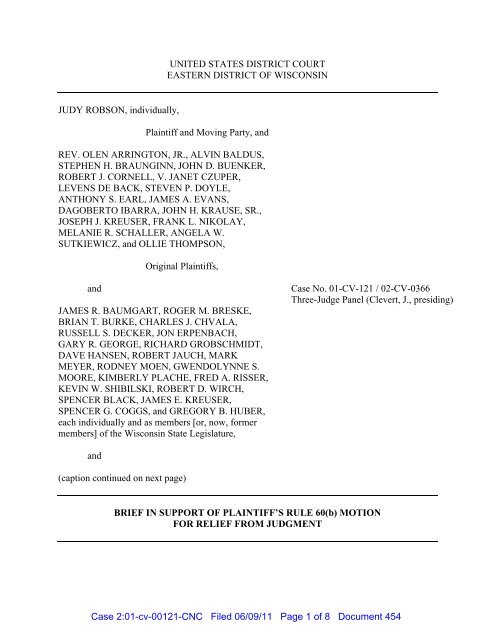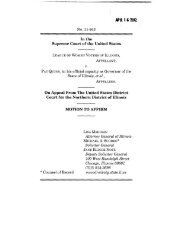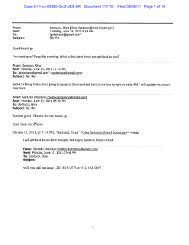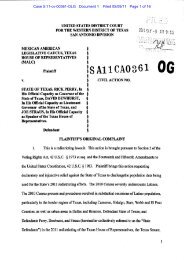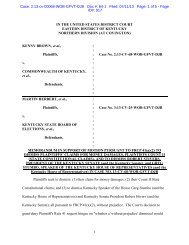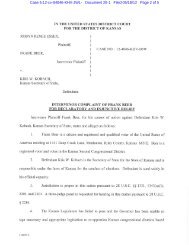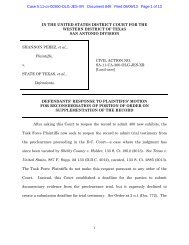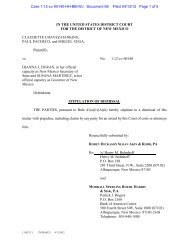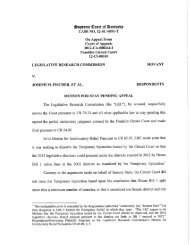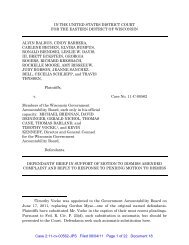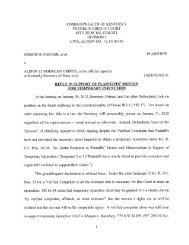Motion for relief from judgment
Motion for relief from judgment
Motion for relief from judgment
Create successful ePaper yourself
Turn your PDF publications into a flip-book with our unique Google optimized e-Paper software.
over-populated districts is diluted. The weight or value of any and every voter in relativelyoverpopulated district is, by definition, less than that of any and every voter in a relatively underpopulateddistrict.Whether legislative district boundaries are court-ordered or legislatively-enacted,changed circumstances—notably, population growth and population shifts measured in thecensus—create new conditions that render the decade-old legislative districts no longerconstitutional. The district boundaries must be redrawn. In Jackson v. De Soto Parish Sch. Bd.,585 F.2d 726, 728-29 (5th Cir. 1978), the U.S. Court of Appeals explicitly acknowledged that“reapportionment plans … are not immutable” and that “[t]he judicial process must be flexibleenough to allow challenges to schemes that have, because of changing population patterns …[,]become unconstitutional in their operation.” Id. at 728. The Sixth Circuit has similarly reasonedthat federal courts have great latitude in fashioning remedies <strong>for</strong> constitutional violations inreapportionment cases. See Rader v. Cliburn, 476 F.2d 182, 184 (6th Cir. 1973).When a court issues a <strong>judgment</strong>, that court can maintain or reassert jurisdiction <strong>for</strong> thesame issues and same parties in subsequent stages of litigation. See King v. State Bd. ofElections, 979 F. Supp. 582, 588-89 (N.D. Ill.) (citing Johnson v. Burken, 930 F.2d 1202, 1207(7th Cir. 1991) (other citations omitted)), vacated, 519 U.S. 978 (1996). Where the prior<strong>judgment</strong> is no longer equitable based on changed circumstances, the court has the authority toset aside its earlier <strong>judgment</strong> and to issue a subsequent, equitable <strong>judgment</strong> based upon the newcircumstances. See Fed. R. Civ. P. 60(b); King v. State Bd. of Elections, 979 F. Supp. at 589. Ofcourse, setting aside a <strong>judgment</strong> is extraordinary, and any party seeking such a remedy mustprovide clear and convincing reasons. Id.; see Williams v. Hatcher, 890 F.2d 993, 995 (7th Cir.1989) (rule requires “exceptional circumstances”).4Case 2:01-cv-00121-CNC Filed 06/09/11 Page 4 of 8 Document 454
en<strong>for</strong>cement [of the prior order and <strong>judgment</strong>] inequitable,” requiring the grant of the motion.De Filippis v. United States, 567 F.2d 341, 344 (7th Cir. 1977).The plaintiff’s Rule 60(b) motion has been filed neither too late nor too soon. The ruleitself notes that the motion must be filed within a “reasonable time.” Only motions under thefirst three subsections of the rule, none applicable here, have a time limit of one year after theentry of the <strong>judgment</strong> or order at issue. Here, the motion could not have been brought at allbe<strong>for</strong>e the release of the 2010 census data, which occurred on March 9, 2011. Nor is the motionpremature.More than ten years ago, on February 1, 2001, voters filed suit in this Court seeking adeclaratory <strong>judgment</strong> that the apportionment plan <strong>for</strong> Congressional districts (legislativelyenacted in 1992) was unconstitutional. They asked <strong>for</strong> an injunction barring elections under thatplan “and, in the absence of subsequent action by state legislators, the institution of ajudicially-crafted redistricting plan.” Arrington v. Elections Bd., 173 F. Supp. 2d 856, 858 (E.D.Wis. 2001) (three-judge panel). Even though the state legislature then “had not yet attempted tocreate a constitutional apportionment plan,” the Court found that the “complaint as filed doespresent a justiciable case or controversy.” Id. at 859. “[C]hallenges to districting laws may bebrought immediately upon release of official data showing district imbalance...,” id. at 860,because existing legislative boundaries become “‘instantly unconstitutional.’” Id. (citationomitted).This Court, with Judge Easterbrook dissenting, fully discussed the concepts of standing,ripeness and jurisdiction. It noted the partisan political division in the state legislature, a divisionthat does not exist today, and concluded that it was “irrelevant <strong>for</strong> standing purposes that theharm may not develop and that the plaintiff may not [ultimately] be entitled to <strong>relief</strong>.” Id. at 862.6Case 2:01-cv-00121-CNC Filed 06/09/11 Page 6 of 8 Document 454
Accordingly, the Court declined to dismiss the case—filed, notably, more than four monthsbe<strong>for</strong>e this motion in the analogous time period—or apply any abstention doctrine.Id. at 866.Boiled down to the bare essentials, there is a case or controversy inthis case because Wisconsin’s current apportionment law isunconstitutional.... The alleged harm is not hypothetical. Whileinjury is by no means certain, the plaintiffs’ fear of injury isrealistic.This Court nonetheless, as a matter of comity, stayed the proceedings <strong>for</strong> several months“until the appropriate state bodies have attempted—and failed—to do so on their own.” Id.at 867. They did attempt, and they did fail. See generally, Baumgart. This motion is in thesame procedural posture as the 2001 complaint, and the plaintiff seeks the same <strong>relief</strong>.Following the precedent in Baumgart, the Court should reassert jurisdiction and, if it deemsnecessary, stay the matter until a date certain, allowing the state legislature the opportunity toexercise its responsibility. However, as this Court did 10 years ago, it should retain jurisdictionbecause the state may fail to meet its obligation to draw constitutionally-apportioned legislativedistricts within a time period that allows the Government Accountability Board, potentialcandidates and Wisconsin citizens sufficient time to prepare <strong>for</strong> the regularly scheduled 2012 fallelections.It is also noteworthy that Rule 60(d) does not “limit” in any way the Court’s authority toadjudicate an “independent action” to relieve a party <strong>from</strong> a “<strong>judgment</strong>, order or proceeding.” Inthe interests of jurisdictional caution, the plaintiff—joined by others—intends to do that, filing inthis Court an independent action under 42 U.S.C. § 1983 embodying the essential allegations ofthis motion. The Court can choose to proceed on either (though not both) or neither (though thedecision in Baumgart establishes that it has jurisdiction to proceed).7Case 2:01-cv-00121-CNC Filed 06/09/11 Page 7 of 8 Document 454
The only way to ensure continuity in Wisconsin’s redistricting litigation is <strong>for</strong> this Courtto reassert jurisdiction, even provisionally, over the redistricting process. Due to the inherentlypolitical nature of drawing district maps, redistricting litigation is susceptible to <strong>for</strong>um shopping.This Court’s decision to set aside its May 2002 <strong>judgment</strong>—and preside over subsequentredistricting litigation made necessary by changed circumstances—will prevent it.CONCLUSIONFollowing the 2010 Census, there can be no question that Wisconsin’s legislative districtboundaries must be redrawn to comply with well-established constitutional standards. ThisCourt should set aside its May 2002 order and <strong>judgment</strong> and preside over the redistrictingprocess to protect constitutional rights and to promote judicial economy and continuity.Dated: June 9, 2011.GODFREY & KAHN, S.C.By:s/ Rebecca Kathryn MasonRebecca Kathryn MasonState Bar No. 1055500Brady C. WilliamsonState Bar No. 1013896One East Main Street, Suite 500P.O. Box 2719Madison, WI 53701-2719Telephone: 608-257-3911Facsimile: 608-257-0609rmason@gklaw.comAttorneys <strong>for</strong> Judy Robson6384817_38Case 2:01-cv-00121-CNC Filed 06/09/11 Page 8 of 8 Document 454


